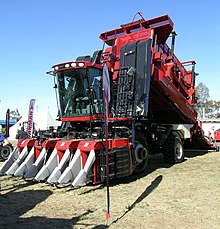| Revision as of 18:45, 18 November 2009 edit204.184.87.1 (talk) →History← Previous edit | Revision as of 04:45, 1 December 2009 edit undoXaronyr (talk | contribs)5 editsm The history that leads to the making of the mechanical cotton pickerNext edit → | ||
| Line 6: | Line 6: | ||
| ==History== | ==History== | ||
| The mechanical Cotton Picker is basically the result of black people getting equal rights. | |||
| In 1850, Taylure and Paige made the first attempt to develop a mechanical cotton picker with the intent on replacing manual labor. Mechanical cotton pickers had no further inventions until the founder of Price Campbell Cotton Picker Corporation created one in 1889. Very little progress was made from then until 1924, when the Price-Campbell patents were purchased by ]. Many experimental machines that were greatly improved from Price-Campbell's inventions were brought out during the period from 1924 until 1939. The idea of mechanical cotton picking began to be practical in 1943, when International Harvester produced the first dozen of their successful commercial cotton pickers. Although there were many attempts to invent successful cotton pickers, their use was not made practical until the 1950s, and even then, it was not immediately implemented on most ]s. | In 1850, Taylure and Paige made the first attempt to develop a mechanical cotton picker with the intent on replacing manual labor. Mechanical cotton pickers had no further inventions until the founder of Price Campbell Cotton Picker Corporation created one in 1889. Very little progress was made from then until 1924, when the Price-Campbell patents were purchased by ]. Many experimental machines that were greatly improved from Price-Campbell's inventions were brought out during the period from 1924 until 1939. The idea of mechanical cotton picking began to be practical in 1943, when International Harvester produced the first dozen of their successful commercial cotton pickers. Although there were many attempts to invent successful cotton pickers, their use was not made practical until the 1950s, and even then, it was not immediately implemented on most ]s. | ||
Revision as of 04:45, 1 December 2009



The mechanical cotton picker is a machine that automates cotton harvesting in a way that reduces harvest time and maximizes efficiency.
History
The mechanical Cotton Picker is basically the result of black people getting equal rights. In 1850, Taylure and Paige made the first attempt to develop a mechanical cotton picker with the intent on replacing manual labor. Mechanical cotton pickers had no further inventions until the founder of Price Campbell Cotton Picker Corporation created one in 1889. Very little progress was made from then until 1924, when the Price-Campbell patents were purchased by International Harvester. Many experimental machines that were greatly improved from Price-Campbell's inventions were brought out during the period from 1924 until 1939. The idea of mechanical cotton picking began to be practical in 1943, when International Harvester produced the first dozen of their successful commercial cotton pickers. Although there were many attempts to invent successful cotton pickers, their use was not made practical until the 1950s, and even then, it was not immediately implemented on most farms.
Conventional Picker
The first pickers were only capable of harvesting one row of cotton at a time, but were still able to replace up to forty hand laborers. The current cotton picker is a self-propelled machine that removes cotton lint and seed (seed-cotton) from the plant at up to six rows at a time.
There are two types of pickers in use today. One is the "stripper" picker, primarily found in use in Texas. It removes not only the lint from the plant, but a fair deal of the plant matter as well (such as unopened bolls). Later, the plant matter is separated from the lint through a process dropping heavier matter before the lint makes it to the basket at the rear of the picker. The other type of picker is the "spindle" picker. It uses rows of barbed spindles that rotate at high speed and remove the seed-cotton from the plant. The seed-cotton is then removed from the spindles by a counter-rotating doffer and is then blown up into the basket. Once the basket is full the picker dumps the seed-cotton into a "module builder". The module builder creates a compact "brick" of seed-cotton, weighing in at approximately 21,000 lb (16 un-ginned bales), which can be stored in the field or in the "gin yard" until it is ginned. Each ginned bale weighs roughly 480 lb (218.2 kg).

In c.2008 the Case IH Module Express 625 was designed in collaboration with ginners and growers to provide a cotton picker with the ability to build modules while harvesting the crop. A similar system was offered by John Deere in 2007
Alternate Meanings
Some people prefer the term cotton harvester to cotton picker when referring to the machine because cotton picker is also regarded as racial slur, a highly derogatory reference for black people, especially African Americans. It is considered very offensive because it makes a direct reference to the days when most African Americans were held as slaves, many of whom were forced to perform manual labor on cotton plantations..
References
- Reuters - "Case IH Module Express 625 Streamlines Cotton Harvest" Retrieved on 9 March 2009
- http://www.deere.com/en_US/newsroom/2007/releases/farmersandranchers/082307_7760picker.html
- Holley, Donald. Mechanical Cotton Picker Encyclopedia article, University of Arkansas at Monticello
- Page, Arthur W. (1910). "A Cotton-Harvester At Last: A Machine That Will Emancipate Cotton From Low-Grade Labor". The World's Work: A History of Our Time. XXI: 13748–13760.
{{cite journal}}:|access-date=requires|url=(help); Cite has empty unknown parameter:|coauthors=(help); External link in|title=|month=ignored (help) - International Harvester article from Engineering & Technology for a Sustainable World
External links
This agriculture article is a stub. You can help Misplaced Pages by expanding it. |